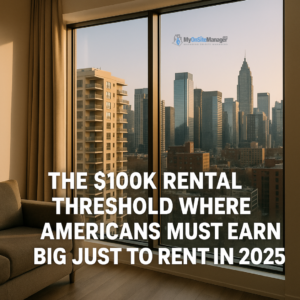For decades, the “American Dream” has been built around the idea of stability, independence, and a roof over one’s head. But in 2025, that dream feels increasingly out of reach for millions of renters. According to new data from Zillow, reported by World Property Journal, the cost of renting has escalated so sharply that in many U.S. metro areas, tenants now need six-figure salaries just to avoid being classified as “rent-burdened.”
This trend underscores a growing affordability crisis that is reshaping where people live, how they spend, and what policymakers must address to prevent long-term economic inequality.
Source: World Property Journal
A Rapid Rise in Rental Costs
Over the past five years, the U.S. rental landscape has transformed dramatically. Zillow’s latest figures show that since 2020:
-
Apartment rents have climbed by nearly 29%.
-
Single-family home rents have surged an astonishing 43%.
At the same time, household incomes haven’t caught up. Median income rose just 22.5% in the same period, reaching roughly $82,000. On paper, that increase might look positive, but when rents are rising nearly twice as fast, renters are left struggling to keep up.
The result? The typical American household now needs to earn at least $80,000 per year to comfortably afford an average rental home. Compare that with 2020, when the threshold was closer to $60,000, and the crisis becomes undeniable.
The $100K Threshold: A New Normal in Major Cities
Eight U.S. metropolitan areas now require households to earn over $100,000 annually to rent without being overburdened by housing costs:
-
San Jose, CA
-
New York, NY
-
Boston, MA
-
San Diego, CA
-
San Francisco, CA
-
Los Angeles, CA
-
Miami, FL
-
Riverside, CA
In these cities, even middle-class families are squeezed. To put it into perspective: while the federal guideline suggests households should spend no more than 30% of income on rent, many of these metros demand significantly more.
Ironically, only San Jose (25%) and San Francisco (28%) renters fall under the “affordable” threshold when comparing median income to median rent largely because incomes in Silicon Valley are substantially higher. For nearly every other metro on the list, affordability is severely strained, even for households earning six figures.
Cities Where Renters Breathe Easier
The situation isn’t universally bleak. In several smaller markets, the cost of living remains far more manageable.
-
Buffalo, NY
-
Oklahoma City, OK
-
Louisville, KY
In these cities, renters need incomes between $55,000 and $57,000 to live comfortably. Housing costs consume closer to 20–23% of income, giving tenants more financial breathing room.
These markets highlight the growing disparity across the country: while coastal metros are becoming unattainable for the average family, smaller or mid-sized cities are emerging as safe havens for renters.
The Hidden Burden of Rental Fees
Rent isn’t the only cost that tenants face. In markets like New York City and Boston, additional fees can make the process even more burdensome:
-
Broker fees
-
First and last month’s rent upfront
-
Security deposits
-
Other “move-in” charges
These can add thousands of dollars to the cost of securing an apartment. For many households, that upfront expense is a dealbreaker forcing them to settle for less ideal housing or stay in place longer than they’d prefer.
To address this, policymakers are beginning to intervene. New York’s proposed FARE Act aims to eliminate or reduce excessive rental fees. Meanwhile, similar reforms are under discussion in Massachusetts and other high-cost states.
Why This Matters Beyond Renters
The consequences of runaway rental costs extend far beyond monthly budgets. They ripple into multiple layers of society and the economy:
-
Reduced Mobility – High rents make it harder for workers to relocate to job-rich metro areas, reducing economic opportunity.
-
Wealth Inequality – Those locked out of homeownership and forced to rent long-term struggle to build equity, widening the wealth gap.
-
Strain on Families – With more income directed toward housing, families cut back on essentials like healthcare, education, or retirement savings.
-
Business Impacts – Employers in expensive cities face recruiting challenges, as talent often can’t afford to live nearby without substantial salaries or subsidies.
What Comes Next?
The Zillow data paints a clear picture: unless meaningful policy changes occur, America’s rental affordability crisis will deepen. Potential solutions range from expanding rental assistance programs and increasing housing supply to strengthening tenant protections and curbing hidden fees.
But without swift action, the divide will continue to grow. For households outside the top income brackets, renting in high-cost metros may soon become not just difficult but impossible.
Final Thoughts
The rental crisis of 2025 is more than a housing issue. It’s a reflection of how income inequality, housing shortages, and policy gaps are reshaping the very fabric of American life.
For many, the promise of opportunity in cities like New York, Los Angeles, or San Francisco now comes with a sobering caveat: even a $100,000 salary may not be enough to make rent feel sustainable.
Until structural reforms address these imbalances, the affordability crisis will remain one of the most pressing economic challenges of this decade.
Source: World Property Journal – U.S. Cities Where Renters Need $100K Salary to Live Doubles Since 2020

